Winter isn’t just about layering up your wardrobe—it’s the perfect season to experiment with protective and stylish hairstyles that keep your locks healthy while making a bold statement.
As temperatures drop and harsh winds threaten to damage your hair, braids emerge as both a practical solution and a fashion-forward choice that’s taking men’s grooming by storm.
This comprehensive guide to 33 Stylish Winter Hair Braids for Men explores everything from classic cornrows to contemporary twisted styles, offering detailed insights into techniques, maintenance tips, and styling variations that suit every face shape, hair type, and personal aesthetic.
Whether you’re looking to protect your natural hair texture, add an edgy dimension to your winter look, or simply try something new this season, these braid styles range from understated and professional to daring and artistic.
You’ll discover step-by-step guidance for achieving each look, learn about the best products to keep your braids fresh throughout the cold months, and understand which styles work best for different occasions—from casual weekend outings to formal winter events.
Get ready to transform your winter hair game with these versatile, eye-catching braid options that prove men’s hairstyling knows no boundaries.
Contents
- 1 1. Classic Cornrows
- 2 2. Two-Strand Twists
- 3 3. Box Braids
- 4 4. Cornrow Ponytail
- 5 5. Faux Hawk Braids
- 6 6. Feed-In Braids
- 7 7. Tribal Braids
- 8 8. Viking-Inspired Braids
- 9 9. Lemonade Braids
- 10 10. Man Braid with Undercut
- 11 11. Zigzag Part Braids
- 12 12. Jumbo Braids
- 13 13. Goddess Braids
- 14 14. Micro Braids
- 15 15. Dutch Braids
- 16 16. Braided Man Bun
- 17 17. Freestyle Braids
- 18 18. Braided Fade
- 19 19. Stitch Braids
- 20 20. Braids with Beads
- 21 21. Braided Mohawk
- 22 22. Invisible Braids
- 23 23. Crown Braids
- 24 24. Braids with Shaved Designs
- 25 25. Infinity Braids
- 26 26. Ladder Braids
- 27 27. Bubble Braids
- 28 28. Braided Frohawk
- 29 29. Neo-Traditional Braids
- 30 30. Waterfall Braids
- 31 31. Hybrid Twist-Braid Styles
- 32 32. Protective Starter Locs with Braids
- 33 33. Seasonal Transitional Braids
- 34 Conclusion
1. Classic Cornrows

Classic cornrows represent the foundation of men’s braiding culture and continue to dominate winter hairstyles with their timeless appeal and protective benefits.
This technique involves braiding hair tightly against the scalp in straight lines or geometric patterns, creating a sleek, low-maintenance look that can last for weeks.
Cornrows work exceptionally well during winter because they keep hair protected from cold winds and dry indoor heating while maintaining a sharp, polished appearance.
Key Benefits:
- Cornrows provide maximum scalp protection against harsh winter elements that can cause dryness and breakage
- The style requires minimal daily maintenance, making morning routines significantly faster during busy winter schedules
- They work beautifully with various hair textures, from tightly coiled to loosely curled patterns
- Cornrows can be styled in countless directions and patterns, offering versatility from simple straight-back designs to intricate geometric formations
Styling Considerations:
- The thickness of each braid can be adjusted to create different aesthetic effects, with thinner braids offering more detail and thicker braids providing a bolder statement
- Proper tension is crucial—braids should be secure without causing discomfort or pulling on the hairline
- Adding hair accessories like beads or metallic cuffs can elevate the look for special winter occasions
- Regular moisturizing of the scalp between braids prevents winter dryness and keeps the style looking fresh
Maintenance Tips:
- Apply lightweight oil to the scalp every few days to combat winter dryness and maintain healthy hair growth
- Sleep with a silk or satin bonnet to preserve the braids and prevent frizzing from friction against cotton pillowcases
- Refresh the style every 2-3 weeks by redoing the hairline braids, which tend to loosen first
- Keep the scalp clean with diluted shampoo applied directly between the braids using an applicator bottle
2. Two-Strand Twists

Two-strand twists offer a softer alternative to traditional braids while delivering the same protective benefits that make them ideal for winter weather.
This technique involves dividing sections of hair into two parts and wrapping them around each other, creating a rope-like effect that’s both stylish and easier to achieve than complex braiding patterns.
The resulting look provides texture, definition, and a more relaxed aesthetic compared to tighter braid styles.
Installation Process:
- Begin with freshly washed and conditioned hair to ensure the twists have a clean foundation and maximum hold
- Apply a twisting cream or butter product that provides hold without creating stiffness or flaking in cold weather
- Section hair systematically, working from back to front to ensure even sizing and consistent results throughout
- Twist each section tightly at the roots but allow slightly looser tension toward the ends to prevent breakage
Style Variations:
- Mini twists create a fuller appearance with more definition and can last longer than larger sections
- Chunky twists offer a bolder, more dramatic look that installs faster but may require more frequent maintenance
- Free-form twists allow for a more organic, individualized pattern that develops unique character over time
- Colored or highlighted twists add visual interest and dimension, particularly striking during the monochromatic winter season
Winter Care Requirements:
- Winter air strips moisture from hair, so apply leave-in conditioner every other day to maintain twist integrity
- Cover twists with a hood when going outdoors in snow or rain to prevent water damage and frizzing
- Avoid excessive manipulation, which can cause the twists to unravel prematurely in dry winter conditions
- Refresh twists every 3-4 weeks by carefully unraveling and retwisting sections that have loosened or developed fuzz
3. Box Braids

Box braids have transcended cultural boundaries to become one of the most popular protective styles for men seeking a distinctive winter look.
Named for the square-shaped sections used during installation, this style creates uniform, individual braids that hang freely and can be worn in countless ways.
Box braids excel in winter conditions by completely protecting natural hair from environmental stressors while offering incredible styling versatility.
Installation Details:
- The process typically requires 4-8 hours depending on braid size and hair length, representing a significant time investment
- Synthetic hair extensions are usually incorporated to add length, thickness, and durability to the finished style
- Section sizes can range from pencil-thin microbraids to chunky statement pieces, each creating distinctly different visual effects
- Professional installation ensures consistent sizing and appropriate tension that won’t damage the hairline or cause traction alopecia
Styling Options:
- Box braids can be worn loose and flowing, pulled into ponytails, formed into top knots, or styled into intricate updos
- The length flexibility allows for dramatic floor-length braids, shoulder-length pieces, or shorter bob-style cuts
- Adding colored extensions creates ombré effects, highlights, or bold solid colors without damaging natural hair with chemicals
- Braids can be accessorized with wraps, beads, shells, or metallic rings that reflect winter’s metallic fashion trends
Longevity and Maintenance:
- When properly maintained, box braids can last 6-8 weeks, making them excellent for the entire winter season
- Weekly washing with diluted shampoo keeps the scalp clean without causing excessive frizz or loosening the braids
- Nightly wrapping with a silk scarf prevents friction damage and maintains the sleek appearance of each braid
- Apply braid spray or light oil to combat winter dryness and add shine that prevents the braids from looking dull or aged
4. Cornrow Ponytail

The cornrow ponytail combines the protective benefits of braided roots with the dynamic movement of loose hair, creating a hybrid style perfect for active men who want both functionality and flair during winter months.
This style features cornrows braided from the hairline toward the crown, where they’re gathered into a ponytail that can be left natural, braided, or twisted.
It’s particularly practical for winter sports and outdoor activities while maintaining a polished appearance.
Design Approaches:
- Straight-back cornrows create a clean, athletic aesthetic ideal for men with active winter lifestyles
- Curved or patterned cornrows add artistic detail that elevates the style from purely functional to fashion-forward
- The number of cornrows can vary from just a few thick braids to many thin ones, depending on desired intricacy
- Cornrows can be braided all the way to the ponytail gathering point or stopped earlier for a different textural effect
Ponytail Variations:
- A high ponytail creates an energetic, youthful vibe and works well for men with longer hair lengths
- Mid-level ponytails offer a balanced, versatile look suitable for both casual and semi-formal winter occasions
- Low ponytails provide a more subdued, sophisticated appearance appropriate for professional environments
- The ponytail itself can be left natural, formed into a single braid, sectioned into multiple braids, or twisted for added dimension
Practical Advantages:
- The style keeps hair completely off the neck and face, reducing irritation from winter scarves and high collars
- Cornrowed sections stay secure even during vigorous winter activities like skiing, snowboarding, or ice skating
- The gathered ponytail can be easily tucked into winter hats without disturbing the braided sections
- Maintenance is simplified since the cornrowed portion requires less frequent attention than loose hair would
5. Faux Hawk Braids
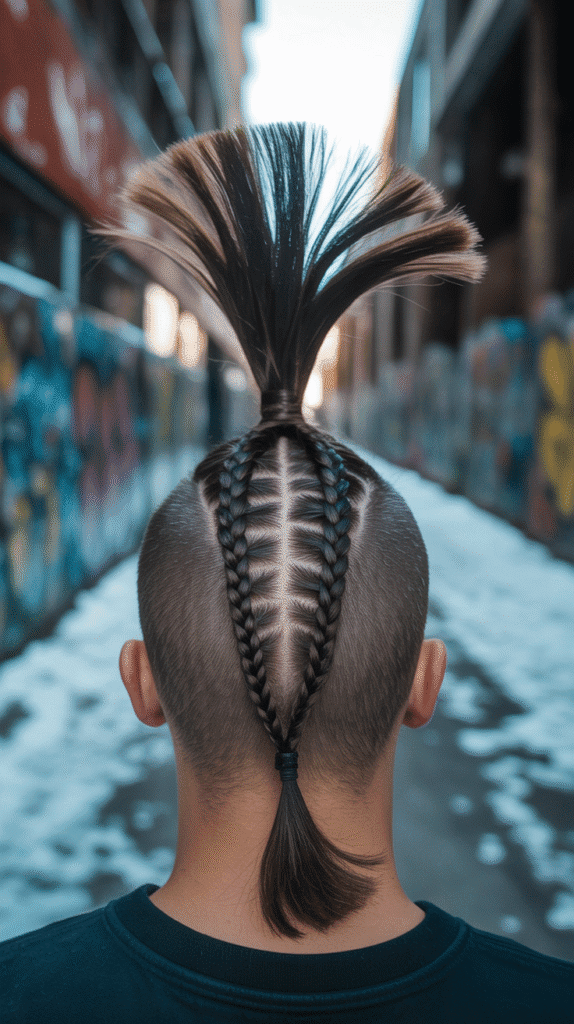
Faux hawk braids deliver an edgy, rebellious aesthetic that’s become increasingly popular among fashion-conscious men seeking to make a statement during the winter season.
This style features braids concentrated in a central mohawk-like strip running from the forehead to the nape, with the sides either braided flat against the scalp, faded, or shaved.
The result is a dramatic, eye-catching look that balances bold styling with the practical benefits of protective braiding.
Structural Elements:
- The central braided section can vary in width from narrow (2-3 inches) to wide (4-6 inches), dramatically affecting the overall appearance
- Height can be enhanced by braiding upward and using products to encourage the braids to stand vertically
- Side sections can feature complementary braids, faded cuts, or designs shaved into the hair for additional visual interest
- The braids in the mohawk section can be thick and bold or thin and numerous, each creating different textural effects
Installation Techniques:
- Starting from a fresh haircut with properly prepared sides ensures clean lines and a polished foundation
- Braiding typically proceeds from front to back, with each braid following the natural mohawk shape
- Extensions can be added for additional length and volume in the central section, creating more dramatic height
- Proper tension distribution prevents the braids from falling flat while avoiding excessive pulling at the roots
Styling and Customization:
- The height of the faux hawk can be adjusted daily using holding products, allowing for versatility between sleek and dramatic looks
- Color can be added to the mohawk section for extra impact, with platinum, burgundy, or vibrant colors being popular winter choices
- Metallic accessories or beads woven into the braids enhance the punk-rock aesthetic of the style
- The look can be toned down for professional settings by braiding the mohawk section flat or styled up for evening events
6. Feed-In Braids
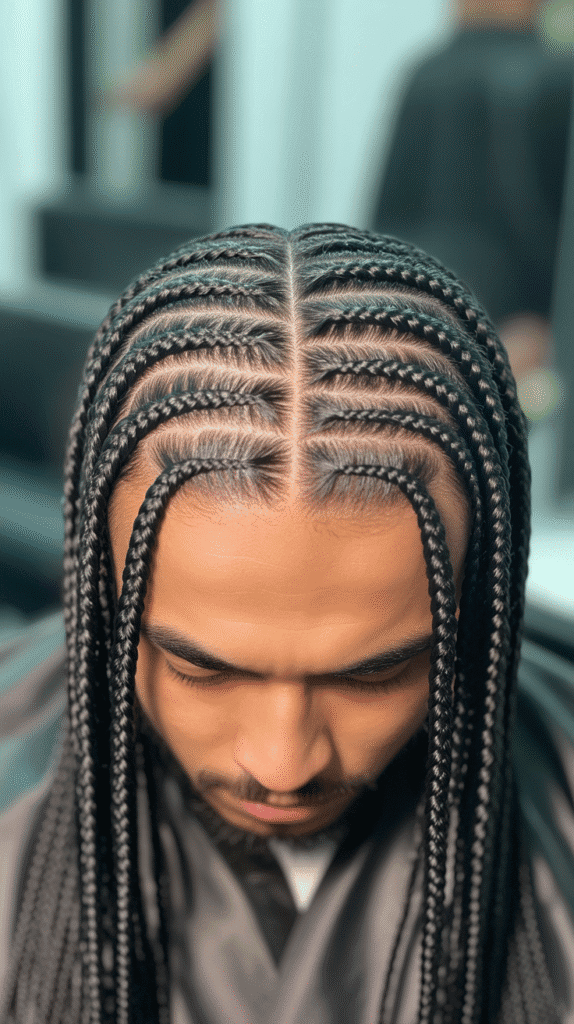
Feed-in braids represent a more refined approach to braiding that creates a natural-looking, gradually thickening effect from root to end.
This technique involves starting with your natural hair and progressively adding small amounts of extension hair as the braid continues, resulting in less tension on the scalp and a more organic appearance.
For winter styling, feed-in braids offer the protection of full extensions with significantly reduced stress on the hairline.
Technical Advantages:
- The gradual feeding technique distributes tension more evenly along the length of each braid, reducing the risk of traction alopecia
- Roots appear more natural since braids begin with only the person’s own hair before extensions are incorporated
- The method allows for greater control over braid thickness, enabling seamless transitions from thin to thick sections
- Feed-in braids typically last as long as traditional extension braids while being gentler on the scalp and edges
Pattern Options:
- Straight-back feed-ins create a classic, timeless look suitable for conservative professional environments
- Curved or S-pattern designs add artistic flair while maintaining the technique’s protective benefits
- Geometric patterns including triangles, diamonds, or zigzags showcase the versatility of the feed-in method
- Asymmetrical designs with varying braid thicknesses create contemporary, fashion-forward winter styles
Winter Maintenance:
- The reduced tension makes feed-in braids more comfortable under winter hats and helmets
- Less stress on the hairline means the style can be maintained longer without concerns about damage
- The natural-looking roots blend better with new growth, extending the time between necessary touch-ups
- Moisturizing requirements remain similar to other braid styles, with focus on keeping the scalp hydrated in dry winter air
7. Tribal Braids
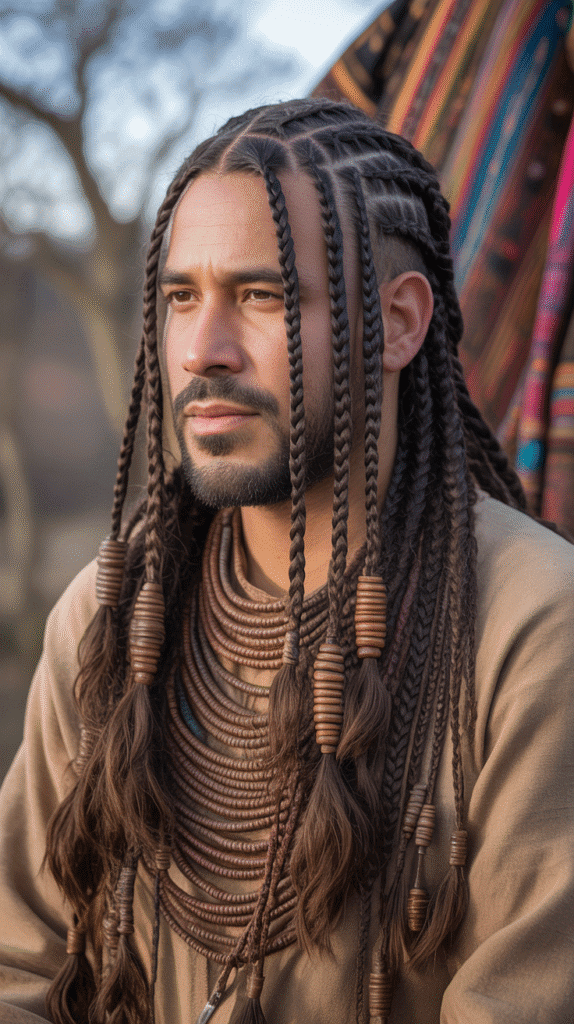
Tribal braids pay homage to traditional African braiding techniques while incorporating contemporary styling elements that resonate with modern fashion sensibilities.
These braids typically feature distinctive patterns, multiple sizes, and sometimes incorporate beads, shells, or other cultural adornments.
During winter, tribal braids serve as both a protective style and a powerful expression of cultural pride and individual identity.
Cultural Significance:
- Tribal braiding patterns carry historical meaning and connect wearers to ancestral traditions and heritage
- Different patterns and adornments can represent various African cultures, regions, and tribal affiliations
- The style celebrates natural hair texture and rejects Eurocentric beauty standards that dominated grooming for decades
- Wearing tribal braids during winter social events and celebrations creates opportunities for cultural education and appreciation
Design Characteristics:
- Braids often vary in size throughout the head, creating dynamic visual interest and textural contrast
- Patterns may incorporate symbols, lines, or shapes that hold specific cultural or personal significance
- Natural materials like wooden beads, cowrie shells, or metal rings are frequently woven into the braids
- The style typically features longer-lasting braids that can withstand several weeks of winter weather exposure
Styling Considerations:
- Research the cultural significance of specific patterns to ensure respectful and appropriate representation
- Work with braiders who understand traditional techniques and can execute authentic designs
- Balance cultural elements with personal style preferences to create a look that feels both meaningful and comfortable
- Consider the weight of adornments when selecting decorative elements, especially for longer wear periods
8. Viking-Inspired Braids

Viking-inspired braids bring historical Norse warrior aesthetics into contemporary men’s grooming, combining braided sections with loose hair to create a rugged, masculine look perfect for winter’s harsh conditions.
This style often features braids along the sides of the head, incorporated into beards, or woven into ponytails and man buns.
The Viking aesthetic aligns naturally with winter’s warrior-like challenge of facing cold weather while maintaining a powerful appearance.
Historical Context:
- Archaeological evidence suggests Norse warriors used braids for practical purposes during battles and long journeys
- The style kept hair manageable during combat and protected it from harsh Scandinavian weather conditions
- Contemporary interpretations blend historical inspiration with modern grooming techniques and products
- The aesthetic has gained popularity through media portrayals of Vikings and growing interest in Norse culture
Common Viking Braid Patterns:
- Side braids that run from temple to behind the ear, often multiple thin braids on each side
- Crown braids that wrap around the top of the head while leaving back sections loose and flowing
- Beard braids that incorporate facial hair into the overall braided aesthetic, creating cohesive masculine styling
- Undercut combinations where braided top sections contrast dramatically with shaved or faded sides
Styling Products and Techniques:
- Texturizing products help create the slightly messy, warrior-aesthetic that defines authentic Viking-inspired styles
- Natural beeswax or pomades provide hold for braids without creating an overly polished appearance
- Leather cords, metal rings, or wooden beads add authentic Viking-inspired adornments
- The style benefits from slightly unwashed hair which provides better grip and texture for braiding
9. Lemonade Braids

Lemonade braids, popularized in contemporary culture, feature side-swept cornrows that cascade diagonally across the head in a distinctive pattern.
While originally associated with women’s styling, men have increasingly adopted this bold look for its unique aesthetic and excellent protective qualities.
The diagonal pattern creates visual movement and works exceptionally well for men with longer hair looking for a winter style that stands out from traditional straight-back cornrows.
Design Specifications:
- Braids are installed in a diagonal direction, typically starting from one side and sweeping toward the opposite side
- The pattern can range from subtle angles to dramatic diagonal lines depending on personal preference
- Braid thickness can vary throughout the head, creating additional dimension and visual interest
- The style works best with medium to long hair length, though shorter versions can be adapted
Installation Process:
- Sectioning begins at the hairline and follows diagonal lines mapped across the entire scalp
- Each braid is installed following the predetermined angle, requiring precision to maintain consistent direction
- Extensions can be added for length, volume, or color variation to enhance the dramatic diagonal effect
- Professional installation is recommended to achieve the signature smooth, uniform appearance
Versatility and Adaptation:
- The braids can be styled into various updos, ponytails, or buns while maintaining their distinctive diagonal flow
- Accessories can be added along the parts or woven into individual braids for personalized flair
- The style transitions well from casual winter weekends to more formal holiday events
- Color gradients or highlights along the diagonal direction create stunning visual effects under winter lighting
10. Man Braid with Undercut
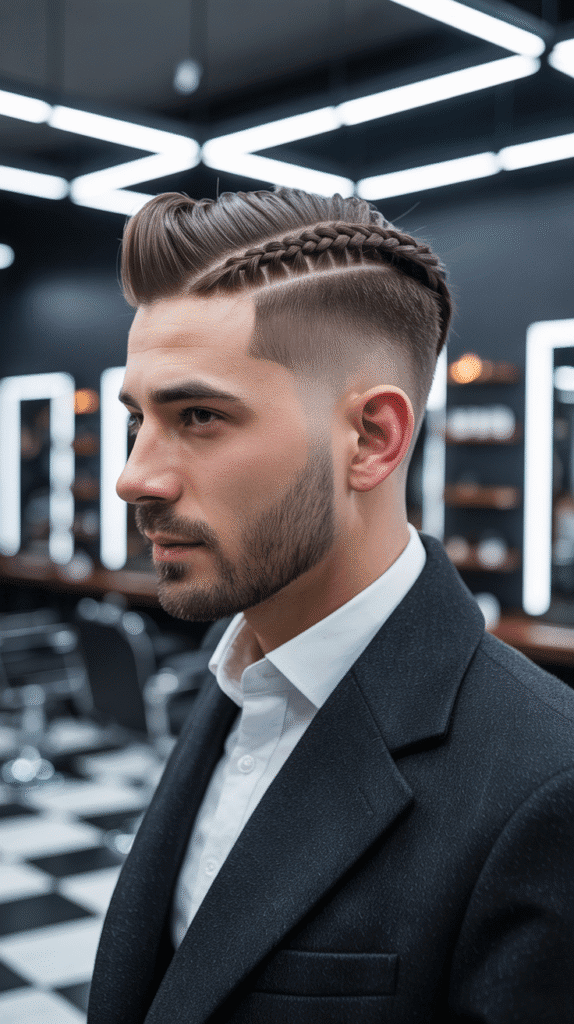
The man braid with undercut represents a contemporary fusion style that combines the edge of modern barbering with traditional braiding techniques.
This look features dramatically short or faded sides and back, with the longer top section braided in various patterns.
The contrast between the clean-cut sides and textured braided top creates a striking aesthetic that’s both professional enough for winter business settings and stylish enough for social occasions.
Structural Components:
- The undercut section can range from a subtle fade to a high-contrast skin fade depending on desired drama
- Top section length determines braiding possibilities, with longer hair allowing for more complex patterns
- The transition between short sides and braided top can be sharp and defined or gradually blended
- This style requires regular barber maintenance for the undercut while the braided section can last several weeks
Braiding Options for the Top Section:
- A single French braid running from forehead to crown creates a clean, streamlined appearance
- Multiple smaller braids across the top add texture and visual complexity to the style
- Braids can be styled into man buns, ponytails, or left to flow naturally depending on length
- Zigzag or curved patterns in the braiding add artistic elements to the otherwise structured look
Maintenance Requirements:
- The undercut portion requires touch-ups every 1-2 weeks to maintain sharp lines and clean appearance
- Braided sections can last 2-4 weeks depending on hair texture and daily activity level
- The contrasting sections allow for easy styling variation without redoing the entire hairstyle
- Winter hats fit comfortably over this style since the bulk is concentrated on top rather than all around
11. Zigzag Part Braids
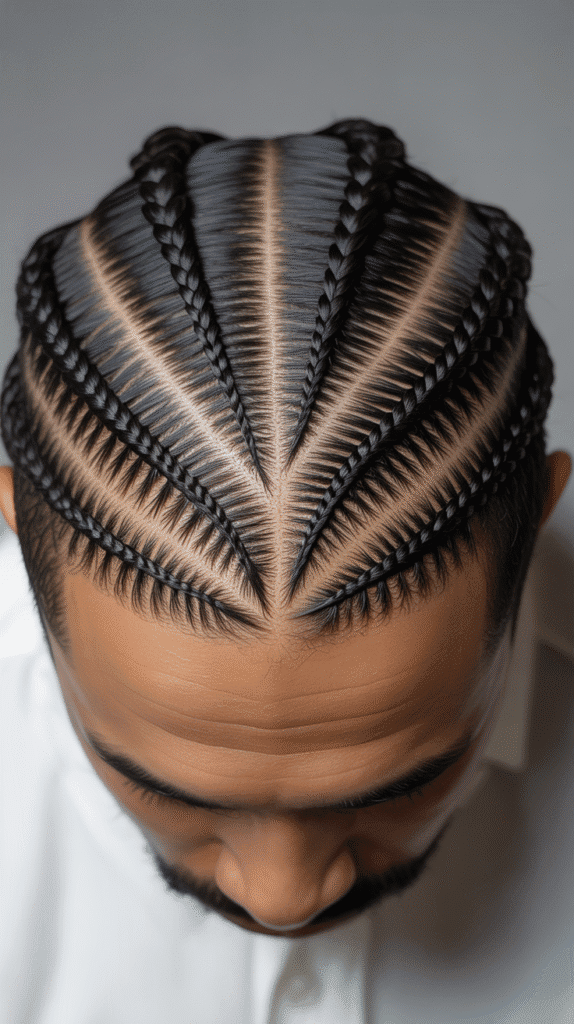
Zigzag part braids transform the traditional straight-line parting into an artistic design element that adds personality and flair to any braided style.
Instead of following simple straight lines between braids, the scalp is exposed in zigzag patterns that create visual movement and interest.
This technique works beautifully in winter when the contrast between braided sections and exposed scalp parts creates striking geometric designs.
Design Techniques:
- A rattail comb is used to create precise zigzag patterns in the scalp before braiding begins
- The amplitude of the zigzag can range from subtle waves to dramatic sharp angles
- Multiple zigzag parts can be incorporated throughout the style for maximum visual impact
- The technique works with various braid types including cornrows, box braids, or feed-in styles
Pattern Variations:
- Symmetrical zigzags on both sides of the head create balanced, harmonious designs
- Asymmetrical patterns offer more contemporary, avant-garde aesthetics for fashion-forward individuals
- The zigzag frequency (tight vs. wide) dramatically affects the overall appearance and complexity
- Combining zigzag parts with straight sections creates interesting contrasts within a single style
Visibility and Maintenance:
- Regular scalp moisturizing keeps the exposed zigzag patterns looking clean and healthy throughout winter
- The intricate parting requires skilled installation to ensure sharp, clean lines that last
- Touch-ups focus on maintaining the clarity of the zigzag patterns as hair grows
- The style photographs extremely well, making it popular for social media and winter event photos
12. Jumbo Braids
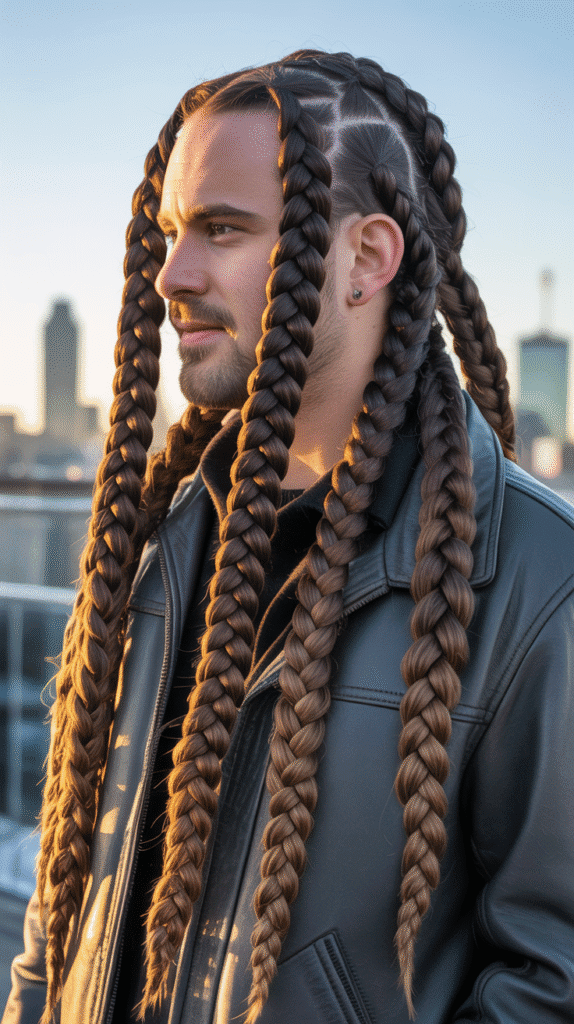
Jumbo braids make a bold statement with their substantial size and dramatic presence, offering a quicker installation process compared to smaller braids while delivering significant visual impact.
These oversized braids require less time to complete yet provide the same protective benefits, making them ideal for men seeking winter hair protection without spending extensive hours in the braiding chair.
The chunky aesthetic aligns perfectly with winter’s layered, substantial fashion trends.
Size and Proportion:
- Individual braids typically measure between one to two inches in thickness, creating significant visual weight
- Fewer braids are needed to cover the head, resulting in installation times of 2-4 hours rather than 6-8
- The larger size means each braid makes a stronger individual statement and shows more of its structure
- Proper sectioning ensures braids are proportional and evenly distributed across the scalp
Installation Considerations:
- Extensions are almost always incorporated to achieve the desired thickness and length in jumbo braids
- The added weight of larger braids requires careful attention to tension to prevent scalp strain
- Fewer braids mean each one must be precisely placed for balanced, aesthetically pleasing coverage
- The style works particularly well for men with thicker hair density who can support the additional weight
Styling Flexibility:
- Jumbo braids can be worn loose, gathered into ponytails, or styled into top knots with ease
- The substantial size makes accessories like large beads, wraps, or cuffs particularly striking
- Color treatments or ombré effects are highly visible on jumbo braids, creating dramatic winter statements
- The style transitions effortlessly from casual winter wear to dressed-up evening looks
Longevity Factors:
- Jumbo braids typically last 3-4 weeks, shorter than smaller braids due to their weight and higher visibility of new growth
- The larger size makes them more prone to frizzing in winter weather, requiring regular maintenance spray application
- Weekly washing is essential to prevent product buildup on the larger surface area of each braid
- Protective sleeping practices are crucial as the weight of jumbo braids can cause more friction damage
13. Goddess Braids
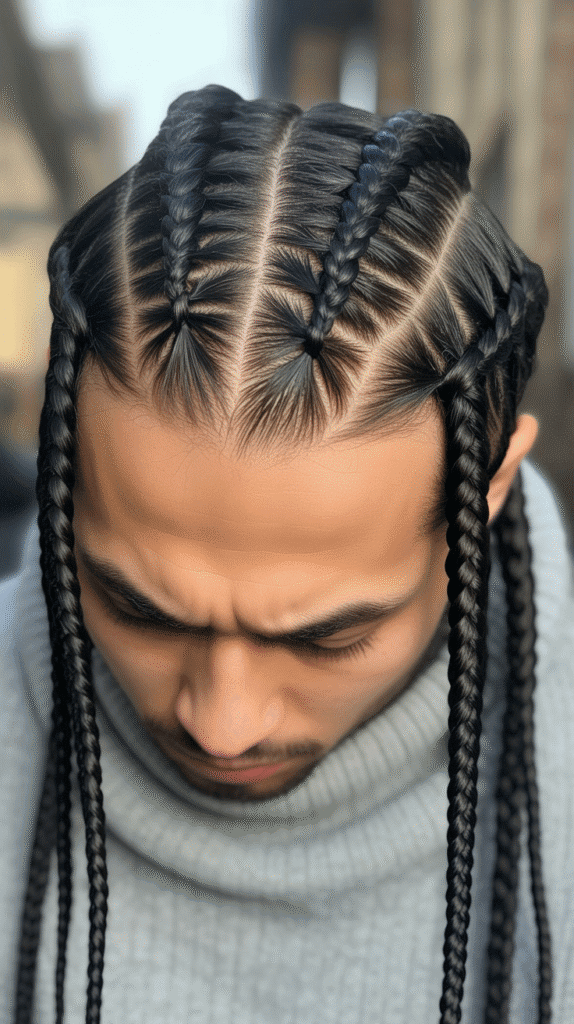
Goddess braids represent an elevated, larger-scale version of traditional cornrows, characterized by their thick, prominent appearance and often intricate patterns.
These braids make a powerful fashion statement while offering excellent protection for natural hair during harsh winter conditions.
The substantial size of goddess braids creates a regal, commanding presence that’s increasingly popular among men seeking distinctive, culturally rooted hairstyles.
Defining Characteristics:
- Goddess braids are significantly thicker than standard cornrows, typically ranging from 1-2 inches in width
- The style usually involves fewer braids (typically 4-8) covering the entire scalp in strategic patterns
- Extensions are commonly incorporated to add length, volume, and visual impact to the finished look
- The braids lie flat against the scalp despite their size, maintaining the protective benefits of cornrows
Popular Pattern Designs:
- Straight-back goddess braids create a clean, powerful aesthetic with 4-6 large parallel braids
- Curved patterns that follow the natural contours of the head add artistic sophistication
- Circular or spiral goddess braids radiating from a central point create unique focal points
- Asymmetrical designs with varying braid sizes add contemporary edge to the traditional technique
Installation and Care:
- Professional installation is highly recommended due to the skill required to create uniform, large-scale braids
- The process typically takes 2-4 hours, considerably less than smaller braid styles
- Winter maintenance involves regular scalp moisturizing and gentle cleansing every 5-7 days
- The style can last 2-3 weeks before requiring touch-ups, with edges typically needing attention first
14. Micro Braids

Micro braids represent the opposite end of the spectrum from jumbo styles, featuring extremely thin, delicate braids that create a fuller, more textured appearance.
While installation requires significant time investment (often 8-12 hours), the result is a versatile, long-lasting protective style perfect for men willing to commit to winter hair protection.
The lightweight nature of individual micro braids reduces tension on the scalp while creating stunning visual density.
Technical Specifications:
- Individual braids measure pencil-thin or smaller, requiring precision and patience during installation
- The style typically involves hundreds of individual braids covering the entire scalp
- Extensions are usually added to achieve desired length and ensure uniform thickness throughout
- Proper sectioning is crucial to ensure even distribution and prevent visible gaps in coverage
Longevity Benefits:
- Micro braids can last 8-12 weeks when properly maintained, covering the entire winter season
- The small size means individual braids experience less stress and maintain their appearance longer
- New growth is less noticeable with micro braids, extending the time between necessary touch-ups
- The lightweight nature reduces tension-related damage compared to heavier braid styles
Styling Versatility:
- The numerous thin braids can be styled in countless ways including ponytails, buns, half-up styles, and free-flowing
- The dense coverage creates a fuller appearance, beneficial for men with thinner or fine hair textures
- Color can be added for highlights, ombré effects, or solid colors without the dramatic look of colored thick braids
- Accessories can be selectively added to a few braids for subtle decoration rather than overwhelming the style
Winter Care Requirements:
- The dense braid coverage requires thorough but gentle cleansing to prevent product buildup and scalp issues
- Nightly protection with silk bonnets or pillowcases is essential to prevent frizzing of the numerous thin braids
- Regular scalp moisturizing between braids maintains healthy hair growth and prevents winter dryness
- The style withstands winter hats and outdoor activities exceptionally well due to the secure, lightweight braids
15. Dutch Braids
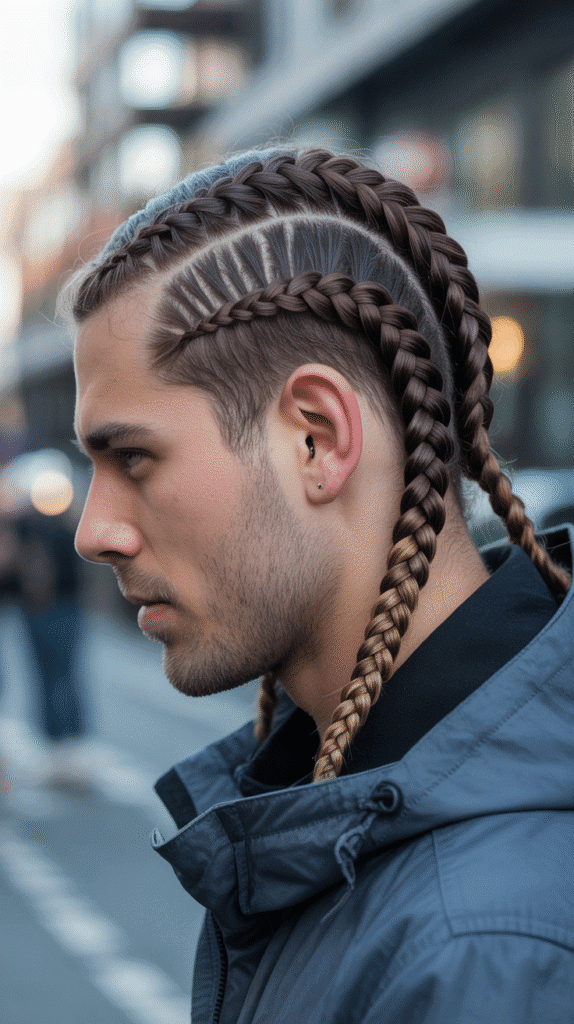
Dutch braids, often called “reverse French braids,” create a raised, three-dimensional effect by crossing hair sections under rather than over during the braiding process.
This technique produces braids that sit prominently on top of the hair rather than lying flat, creating striking visual dimension.
For men’s winter styling, Dutch braids offer a contemporary, fashion-forward alternative to traditional flat-braiding methods.
Braiding Technique:
- The Dutch braiding method involves crossing outer sections under the middle section rather than over it
- This creates a braid that appears to sit on top of the remaining hair rather than sinking into it
- The technique works with various hair lengths, though medium to long hair showcases the effect most dramatically
- Dutch braids can be executed as single central braids, multiple parallel braids, or incorporated into more complex designs
Style Variations:
- A single Dutch braid running from forehead to nape creates a bold central statement piece
- Two parallel Dutch braids on either side of a central part offer a balanced, symmetrical look
- Multiple thin Dutch braids across the scalp create textured, dimensional effects
- Dutch braids can transition into ponytails, buns, or be left to hang freely depending on hair length
Visual Impact:
- The raised appearance of Dutch braids catches light differently than flat braids, creating interesting shadows and highlights
- The three-dimensional quality makes the braiding technique itself more visible and appreciated
- Dutch braids photograph exceptionally well, making them popular for winter portraits and social media
- The pronounced texture pairs beautifully with winter’s textured fashion trends like cable knits and woven fabrics
Maintenance:
- Dutch braids typically last 2-5 days depending on hair texture and activity level, shorter than cornrows but longer than loose styles
- Regular re-braiding is necessary but the process is quick compared to installation of permanent protective styles
- The style allows for easy daily hair washing since the braids can be quickly undone and recreated
- Sleeping with loose Dutch braids or in a protective style preserves them overnight for multi-day wear
16. Braided Man Bun
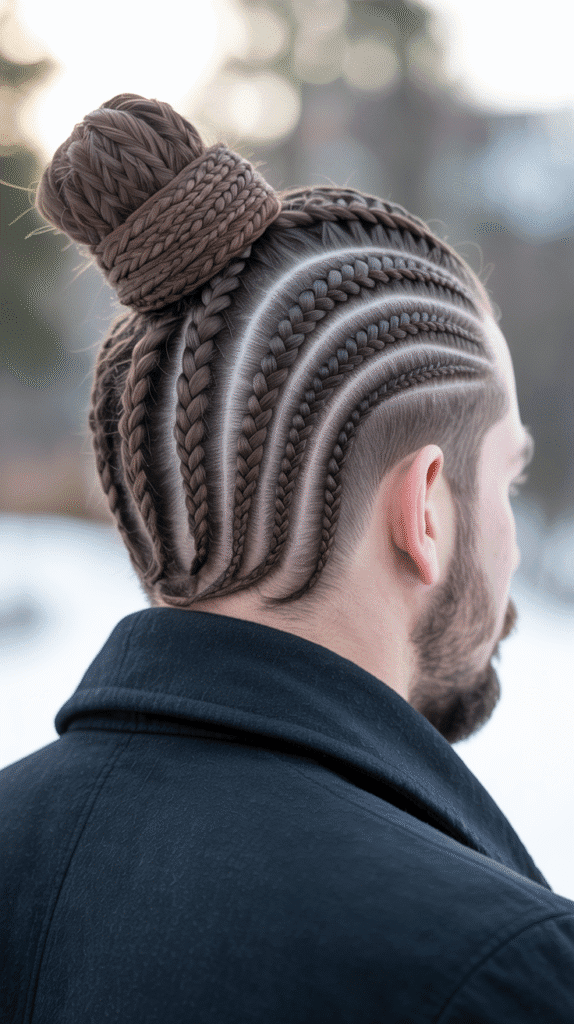
The braided man bun combines two major men’s hairstyle trends into one cohesive, winter-appropriate look that’s both practical and stylish.
This style features hair braided from the hairline or sides toward the crown, where it’s gathered and secured into a bun formation.
The result keeps hair completely secured against winter weather while creating a distinctive appearance that works across casual and semi-formal settings.
Construction Methods:
- Hair can be braided entirely from front to back before being wound into the bun formation
- Alternatively, sides can be braided while the top section remains loose until being pulled into the bun
- Multiple smaller braids can feed into a single bun, creating complex textured effects
- The braiding can incorporate undercut or faded sides for added contrast and definition
Bun Placement and Size:
- High buns create a more casual, relaxed aesthetic suitable for everyday winter wear
- Mid-level buns offer versatility for both casual and professional environments
- Low buns provide a sophisticated, refined appearance appropriate for formal winter occasions
- Bun size can range from small and subtle to large and statement-making depending on hair volume and extensions
Functional Benefits:
- The secured nature of braided man buns prevents hair from blowing around in winter winds
- The style fits comfortably under winter hats, beanies, and hoods without becoming disheveled
- Hair stays completely off the neck, preventing irritation from scarves and high collars
- The bun can be quickly undone and re-secured without requiring complete re-braiding
Styling Variations:
- Messy braided buns offer a relaxed, effortless appearance perfect for casual winter weekends
- Sleek, tight buns create polished looks suitable for professional settings or formal events
- Buns can be positioned at various angles rather than sitting directly on top of the crown
- Accessories like leather wraps, metal cuffs, or decorative pins can enhance the bun’s appearance
17. Freestyle Braids
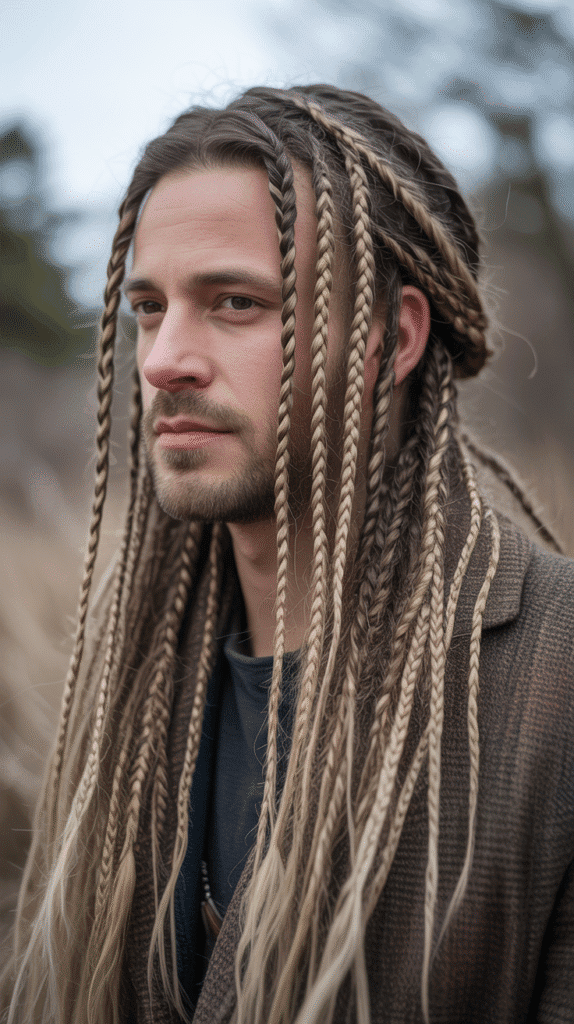
Freestyle braids embrace organic, individualized patterns that develop naturally over time rather than following predetermined designs.
This approach allows hair to form braids that reflect personal movement patterns, sleeping positions, and natural hair behavior.
Popular in natural hair communities, freestyle braiding creates unique, ever-evolving styles that make excellent winter protective options for men seeking low-maintenance, individualistic looks.
Philosophy and Approach:
- Freestyle braiding rejects rigid uniformity in favor of organic, natural-looking results
- The style develops character over time as braids mature, tighten, and develop individual personalities
- This method honors natural hair texture without forcing it into unnatural patterns or excessive tension
- The approach requires patience as the full aesthetic develops over weeks and months rather than immediately
Installation Process:
- Initial braiding follows natural hair sections rather than precise geometric patterns
- Braid sizes vary throughout the head, creating organic rather than manufactured uniformity
- Minimal product is used to allow hair to form and hold braids through its natural texture
- The process is typically quicker than precise pattern braiding since perfection isn’t the goal
Development and Maturation:
- New freestyle braids appear somewhat irregular but develop more definition as they settle over 2-4 weeks
- Individual braids may combine or separate naturally as they mature, contributing to the organic aesthetic
- The style becomes more distinct and personalized the longer it’s maintained
- Color changes, tips lightening, and texture variations add to the unique character of freestyle braids
Maintenance Philosophy:
- Minimal manipulation allows braids to develop without interference or forced conformity
- Palm rolling helps maintain braid structure without creating artificial perfection
- Washing every 1-2 weeks with residue-free products prevents buildup while allowing natural development
- The style requires acceptance of imperfection and appreciation for organic beauty
18. Braided Fade
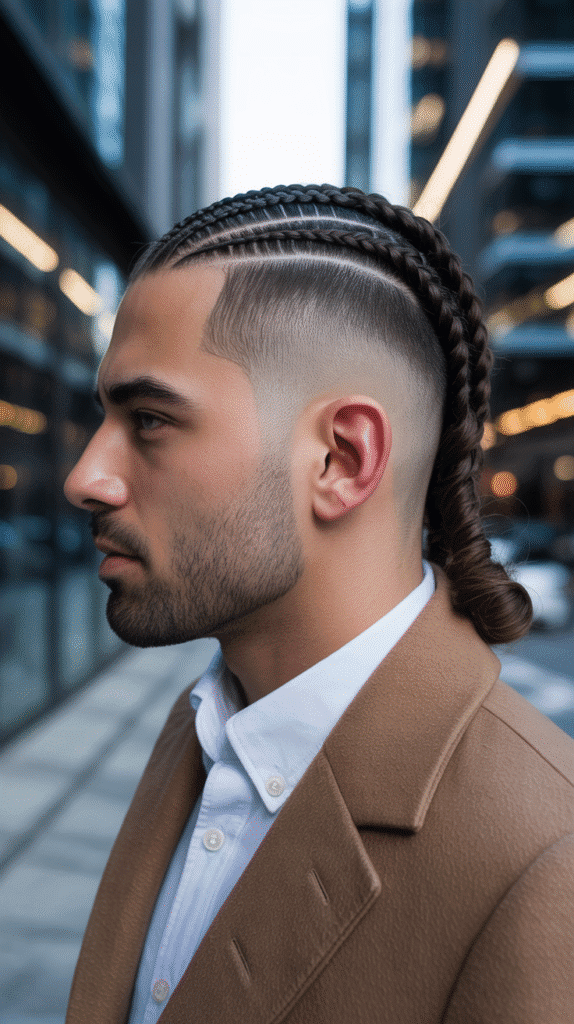
The braided fade represents a sophisticated fusion of barbering precision and braiding artistry, combining meticulously executed fade cuts with braided top sections.
This hybrid style delivers the best of both worlds—the clean, sharp aesthetic of modern barbering with the protective and stylish benefits of braiding.
During winter months, the braided fade offers practical advantages while maintaining a polished, professional appearance suitable for various settings.
Fade Specifications:
- The fade can range from low (starting just above the ears) to high (beginning near the temples) depending on desired contrast
- Skin fades create maximum contrast with the braided sections, delivering bold, dramatic effects
- Taper fades offer subtler transitions for more conservative professional environments
- The fade portion requires regular maintenance every 1-2 weeks to preserve sharp lines and gradual color transitions
Braiding Options for Top Section:
- Cornrows running from front to back create streamlined, athletic aesthetics
- Box braids on top contrast beautifully with the clean fade on sides and back
- Single or multiple French/Dutch braids add dimensional texture to the top section
- Free-form or twisted sections provide organic contrast to the precision-cut fade
Design Integration:
- The transition line between fade and braids can feature designs, parts, or geometric patterns carved into the hair
- Hair designs in the fade section complement and enhance the braided aesthetic
- Color application in either the fade or braided section creates additional visual interest
- The contrast in textures between smooth fade and textured braids creates dynamic visual appeal
Practical Considerations:
- Winter hats sit comfortably on this style since bulk is concentrated on top rather than around the entire head
- The fade stays cooler than full-coverage styles, beneficial for transitioning between cold outdoor and heated indoor environments
- Professional settings particularly appreciate the clean, groomed appearance of the faded sides
- The style requires coordination between barber and braider unless one professional possesses both skill sets
19. Stitch Braids
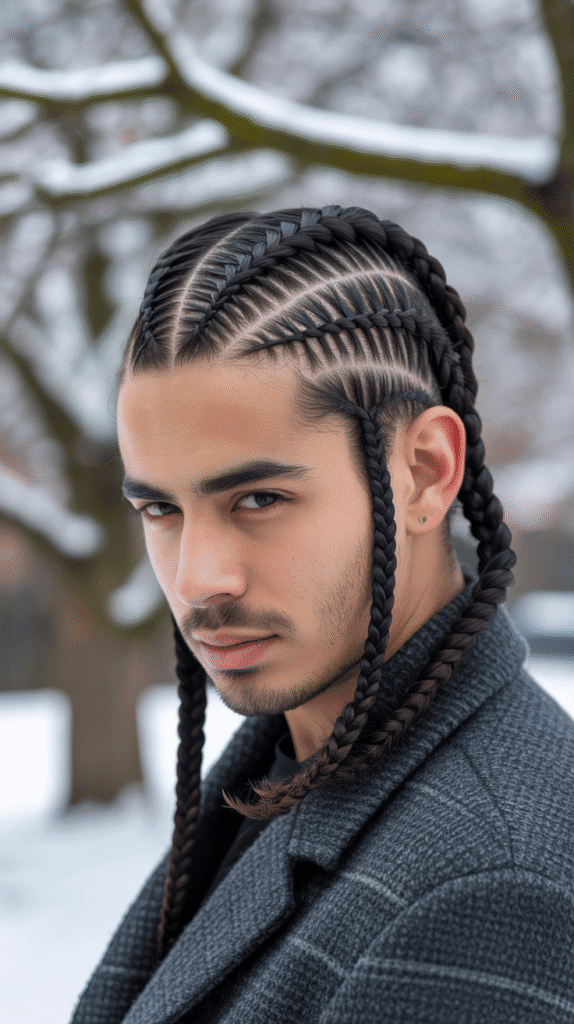
Stitch braids represent an advanced cornrow technique that creates a distinctive raised, stitched appearance through precise hair placement during the braiding process.
This method produces clearly defined, uniform horizontal lines across each braid that resemble actual stitching.
The meticulous technique results in exceptionally neat, artistic braids perfect for men seeking highly polished winter hairstyles that showcase technical braiding excellence.
Technical Execution:
- The braiding technique involves picking up very small, uniform sections of hair at regular intervals
- Each addition creates a visible horizontal line across the braid, producing the signature “stitched” appearance
- Consistent section sizing throughout maintains the uniformity that defines high-quality stitch braids
- The method requires advanced braiding skills and typically takes longer than standard cornrows
Visual Characteristics:
- The horizontal stitch lines create textured patterns across each braid that catch light distinctively
- Precision in execution is highly visible, making this style showcase the braider’s technical abilities
- The raised, defined appearance remains intact longer than standard cornrows due to the secure technique
- Stitch braids photograph exceptionally well, with the stitched texture creating interesting visual detail
Pattern Possibilities:
- Traditional straight-back patterns allow the stitch detail to be the primary visual focus
- Curved or geometric patterns add complexity while maintaining the technical stitching throughout
- Varying braid thickness creates additional dimension while preserving the stitched texture
- Asymmetrical designs showcase the versatility of the stitching technique across different braid directions
Maintenance and Longevity:
- The secure technique typically allows stitch braids to last 3-4 weeks before requiring touch-ups
- The clearly defined appearance shows frizzing more visibly, requiring diligent edge control and maintenance
- Regular application of edge control and braid spray preserves the crisp, stitched appearance
- Winter conditions can dry out braids faster, necessitating consistent moisturizing to maintain the polished look
20. Braids with Beads
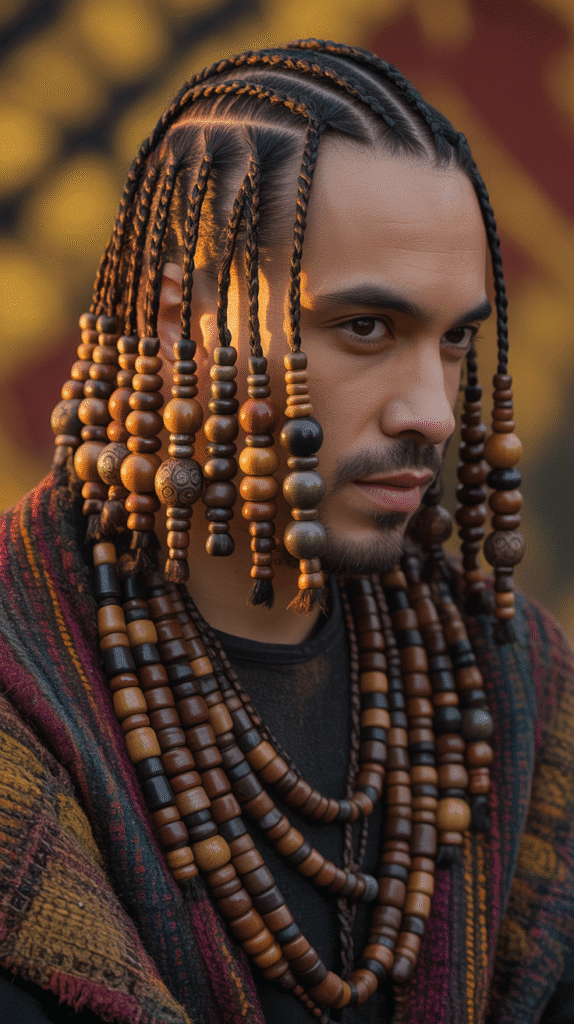
Incorporating beads into braided hairstyles transforms protective styling into wearable art, adding personality, cultural significance, and visual interest to winter looks.
Beads have adorned braids across cultures for centuries, serving purposes from spiritual significance to pure decoration.
For modern men, beaded braids offer opportunities for self-expression, cultural connection, and distinctive style that stands out during the winter season’s social gatherings and celebrations.
Bead Selection:
- Wooden beads provide natural, earthy aesthetics and lighter weight for comfortable extended wear
- Metal beads in gold, silver, or copper tones add luxurious, eye-catching elements to braided styles
- Plastic beads offer affordable variety in colors, sizes, and shapes for experimental or temporary looks
- Glass beads catch winter light beautifully, creating subtle sparkle and dimensional effects
Placement Strategies:
- Beads at braid ends create movement and sound, traditional in many African braiding cultures
- Scattered placement throughout braids adds visual interest without overwhelming the overall style
- Uniform bead placement at consistent intervals creates rhythmic, pattern-focused aesthetics
- Color-coordinated bead arrangements can match winter wardrobes or create intentional contrasts
Installation Techniques:
- Threading beads onto braids requires appropriate bead hole sizes that accommodate braid thickness
- Securing beads with small rubber bands or hair ties prevents sliding and keeps them positioned correctly
- Some beads feature clamps or clips designed specifically for braid attachment
- Lighter beads in greater numbers often work better than heavy beads that can strain braids and scalp
Cultural Considerations:
- Many beading traditions carry cultural and spiritual significance that should be respected and understood
- Researching the cultural context of specific beading patterns demonstrates respect and appreciation
- Some bead arrangements indicate age, status, or tribal affiliation in traditional contexts
- Balancing cultural appreciation with personal expression requires thoughtfulness and education
Practical Factors:
- Beaded braids create additional weight that may affect comfort during extended wear
- Sleeping with beaded braids requires extra protection to prevent beads from pressing into the scalp
- Beads can be removed and reapplied, allowing style variation without re-braiding
- Winter accessories like hats may not fit comfortably over heavily beaded styles
21. Braided Mohawk

The braided mohawk combines punk rock edge with intricate braiding techniques to create one of the most dramatic winter hairstyles available.
This style features a central strip of braided hair running from the forehead to the nape, with sides either braided flat, faded, or shaved.
The height, width, and complexity of the central mohawk section can be adjusted to suit personal style preferences, from subtle to extremely bold.
Structural Design:
- The central mohawk strip typically measures 2-5 inches in width, with wider versions making bolder statements
- Braiding within the mohawk section can run vertically, be woven in complex patterns, or combine multiple techniques
- Side sections most commonly feature close fades or simple flat cornrows that direct attention to the mohawk
- Height can be enhanced through braiding techniques, extensions, or styling products that encourage vertical positioning
Braiding Techniques for the Mohawk:
- Single thick braid running the length of the mohawk creates clean, streamlined aesthetics
- Multiple smaller braids within the mohawk strip add texture and complexity
- Dutch braiding creates raised effects that emphasize the mohawk’s three-dimensional presence
- Incorporating twists alongside braids introduces additional textural variation
Styling Versatility:
- The mohawk can be styled to stand upright for maximum impact or laid flat for more subtle presentation
- Length variations allow for mohawks that extend into ponytails or remain close-cropped
- Color application to just the mohawk section creates striking contrast without full-head commitment
- Accessories like metal rings or leather wraps enhance the punk-inspired aesthetic
Maintenance Requirements:
- The faded or shaved sides require weekly touch-ups to maintain clean lines and proper contrast
- Braided mohawk sections can last 2-4 weeks depending on technique and hair texture
- The dramatic style requires confidence and commitment, as it draws significant attention
- Professional installation ensures balanced proportions and proper execution of the complex design
22. Invisible Braids
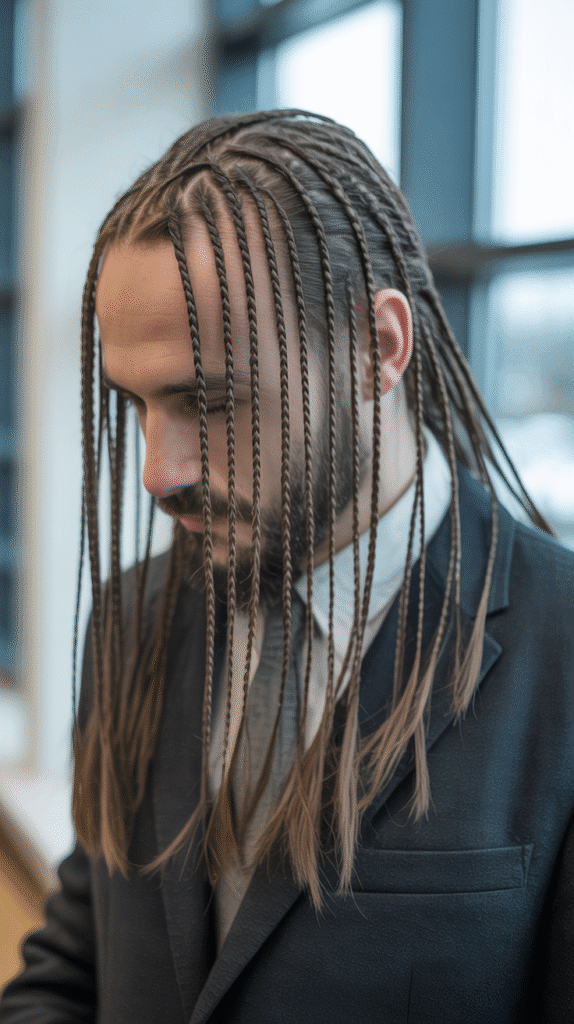
Invisible braids, also known as ghost braids, utilize extremely fine hair sections and transparent or color-matched extension materials to create a delicate, almost ethereal appearance.
These braids appear to float on the scalp rather than sitting heavily, creating subtle, sophisticated styles perfect for professional winter environments.
The technique requires exceptional skill to achieve the characteristic lightweight, barely-there aesthetic.
Technical Specifications:
- Individual braids are thinner than micro braids, often no thicker than a strand of thread
- Clear or precisely color-matched extensions blend seamlessly with natural hair color
- The braiding technique uses minimal tension to create soft, flexible braids rather than rigid ones
- Installation requires 10-15 hours due to the extremely small sections and delicate handling required
Aesthetic Qualities:
- The resulting style appears almost like natural loose hair from a distance, with braided texture visible upon closer inspection
- The lightweight nature creates natural movement and flow unlike heavier braid styles
- Invisible braids work particularly well for men seeking protective styling without obvious braided appearance
- The subtle aesthetic suits conservative professional environments where bold styles might be inappropriate
Longevity and Care:
- Despite their delicate appearance, invisible braids can last 6-10 weeks when properly maintained
- The minimal tension reduces stress on the scalp and edges, making this among the healthiest protective options
- Winter care focuses on preventing the fine braids from drying out and becoming brittle
- The style withstands winter hats exceptionally well due to the minimal bulk and flexible nature
Styling Options:
- Invisible braids can be worn loose, allowing natural movement and flow
- The fine texture allows for easy updos, ponytails, and buns that appear polished and refined
- Color can be incorporated subtly through highlights woven throughout rather than bold blocks
- The delicate aesthetic pairs beautifully with formal winter attire for business and special occasions
23. Crown Braids
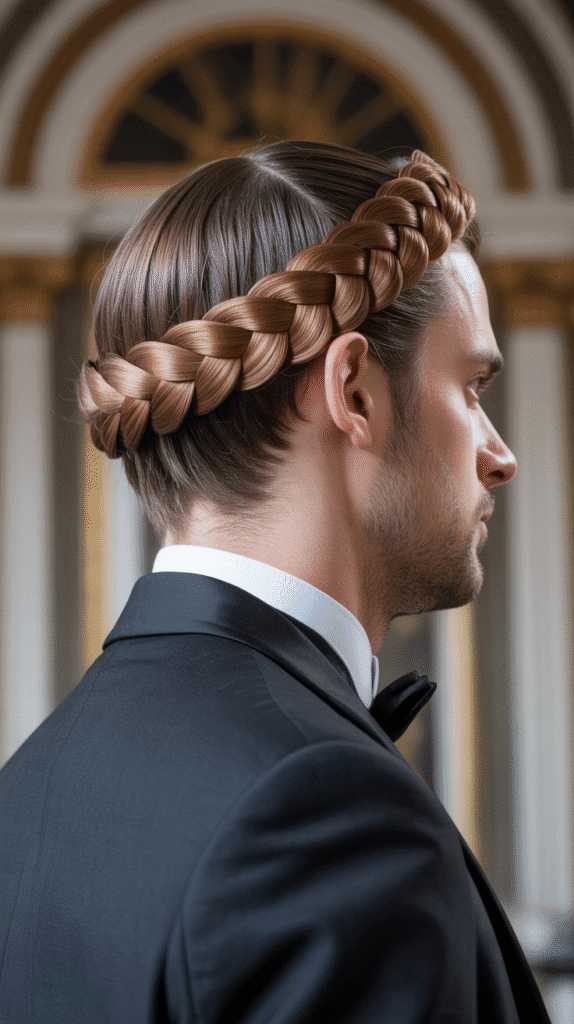
Crown braids create regal, sophisticated aesthetics by wrapping braided sections around the head like a crown or halo.
This style keeps hair secured away from the face while creating a distinctive, polished appearance perfect for winter formal events and professional settings.
The circular or semi-circular braiding pattern follows the natural head shape, producing balanced, symmetrical results that work across various hair lengths and textures.
Construction Methods:
- A single continuous braid circles the entire head, with the beginning and end tucked and secured invisibly
- Multiple parallel braids follow circular paths at different heights, creating layered crown effects
- Dutch braiding creates raised crowns that sit prominently atop the head
- French braiding produces flatter, more subtle crown presentations
Pattern Variations:
- Full crowns circle the entire head, creating complete halo effects visible from all angles
- Half crowns arch across the front or top, leaving back sections in different styles
- Double or triple crown layers add dimension and complexity to the basic circular pattern
- Asymmetrical crowns follow partial circular paths for contemporary, less traditional aesthetics
Styling Applications:
- Crown braids work exceptionally well for formal winter occasions including weddings, galas, and holiday parties
- The style keeps hair completely secured, making it practical for winter sports and outdoor activities
- Professional environments appreciate the neat, controlled appearance that projects polish and attention to detail
- The regal aesthetic pairs beautifully with formal winter attire and cultural dress
Technical Considerations:
- Proper tension distribution ensures comfort while maintaining the crown’s shape and definition
- The braiding typically begins at one ear and proceeds around the head in the desired direction
- Hair length requirements vary, with minimum shoulder-length hair needed for full crowns
- Extensions can be incorporated to add length, thickness, or color variation to the crown
24. Braids with Shaved Designs
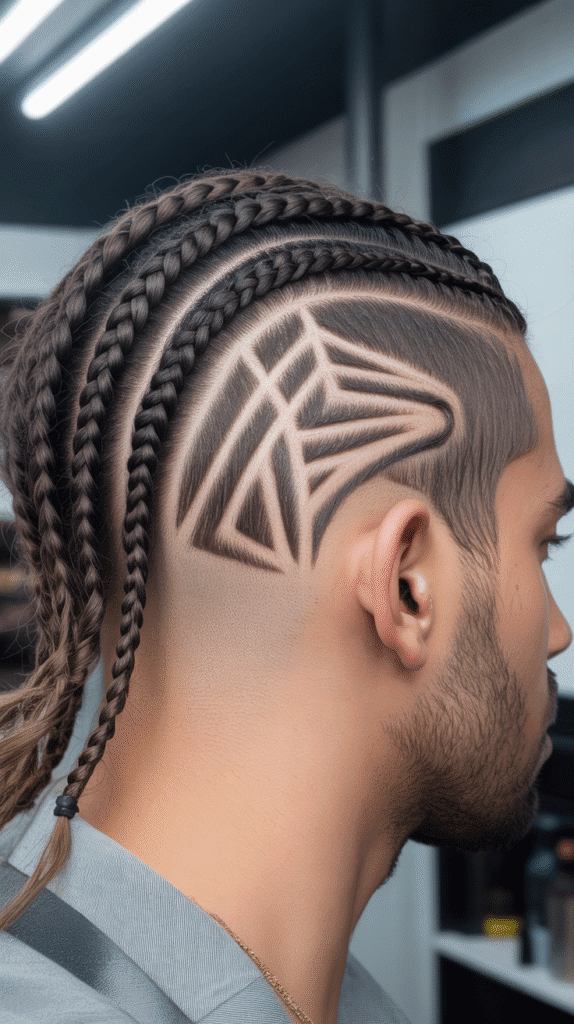
Combining intricate braided sections with precisely shaved designs creates multi-dimensional winter hairstyles that showcase both barbering and braiding artistry.
The shaved areas provide negative space that emphasizes the braided sections, while carved designs add artistic elements that personalize the style.
This approach allows for highly customized looks that range from subtle professional styles to bold artistic statements.
Design Integration:
- Geometric patterns shaved into sides complement the linear nature of braided sections
- Tribal or cultural symbols carved into shaved areas add personal meaning and cultural connection
- Abstract or artistic designs showcase creativity and individual style preferences
- Simple lines and parts maintain professional appearance while adding visual interest
Technical Execution:
- Precision clippers and trimmers create clean, sharp design edges that define the artistic elements
- Designs are typically placed in faded or shaved sections rather than within braided areas
- The contrast between hair and shaved skin makes designs highly visible and impactful
- Complex designs require skilled barbers with steady hands and artistic vision
Popular Design Placements:
- Temple areas provide prominent locations for designs that frame the face
- Side sections between cornrows allow for patterns that complement braid directions
- Back sections feature designs visible when hair is styled up or braided forward
- Undercut areas beneath longer top sections create hidden designs revealed when hair is styled certain ways
Maintenance Considerations:
- Shaved designs require weekly touch-ups to maintain crisp, clear edges and visibility
- Hair growth gradually obscures designs, necessitating regular refreshing or redesign
- The combination style requires visits to professionals skilled in both barbering and braiding
- Winter hats can flatten braided sections while leaving shaved designs unaffected
25. Infinity Braids

Infinity braids utilize advanced braiding techniques that create figure-eight or infinity symbol patterns within the braided structure itself.
This complex method produces visually striking results that appear intricate and mathematically precise.
The technique requires significant skill and time investment but delivers unique winter hairstyles that serve as conversation pieces and artistic expressions.
Braiding Methodology:
- The technique involves crossing hair sections in figure-eight patterns rather than standard three-strand weaving
- Each “infinity loop” requires careful tension control to maintain the distinctive shape
- The method can be applied to single statement braids or incorporated throughout full protective styles
- Proper execution creates visible loops that clearly show the infinity pattern
Visual Impact:
- The mathematical precision of infinity patterns creates sophisticated, intellectual aesthetics
- The complex structure catches light at multiple angles, creating dimensional effects
- Infinity braids work as focal points in otherwise simple styles or throughout complex designs
- The distinctive pattern is immediately recognizable and sets the style apart from standard braiding
Application Methods:
- Single infinity braid running down the center as a statement piece with sides in complementary styles
- Multiple infinity braids throughout the head create consistent patterned texture
- Combining infinity braids with standard braids creates contrast between simple and complex sections
- The technique can be applied to beard braids as well, creating cohesive facial and scalp styling
Time and Skill Requirements:
- Infinity braiding requires significantly more time than standard techniques due to complexity
- Professional braiders with specific training in advanced techniques execute these styles most successfully
- The intricate nature means these styles are typically reserved for special occasions rather than daily wear
- Proper maintenance preserves the distinctive pattern, which can blur if not cared for correctly
26. Ladder Braids

Ladder braids create the visual appearance of horizontal rungs connecting parallel vertical braids, resembling an actual ladder structure.
This creative technique combines braiding skills with strategic hair placement to produce geometric, architecturally-inspired hairstyles.
The striking visual effect works beautifully for winter occasions where unique, artistic presentation is desired.
Construction Technique:
- Two or more parallel cornrows serve as the vertical “rails” of the ladder structure
- Small sections of hair are strategically left unbraided between the parallel braids
- These connecting sections are then crossed horizontally to create the “rungs” of the ladder
- Proper spacing and consistent sizing maintain the clear ladder appearance
Design Variations:
- Single ladder running down the center creates a bold focal point
- Multiple ladders side by side produce complex, repeating geometric patterns
- Curved ladder paths following head contours add organic flow to the geometric concept
- Varying rung spacing creates different visual rhythms within the same basic structure
Styling Context:
- Ladder braids work best as accent pieces within larger hairstyles rather than covering entire heads
- The technique showcases braiding artistry and technical skill, making it popular for competitions and photo shoots
- The geometric precision aligns with winter’s architectural fashion influences and structured design trends
- Color contrast in the connecting rungs enhances visibility and emphasizes the ladder structure
Practical Considerations:
- The exposed horizontal sections require careful maintenance to prevent frizzing
- The style typically lasts 1-2 weeks, shorter than fully enclosed braid styles
- Professional installation is essential to achieve clean, properly spaced ladder effects
- The technique works best with medium to thick hair density that can support the structure
27. Bubble Braids
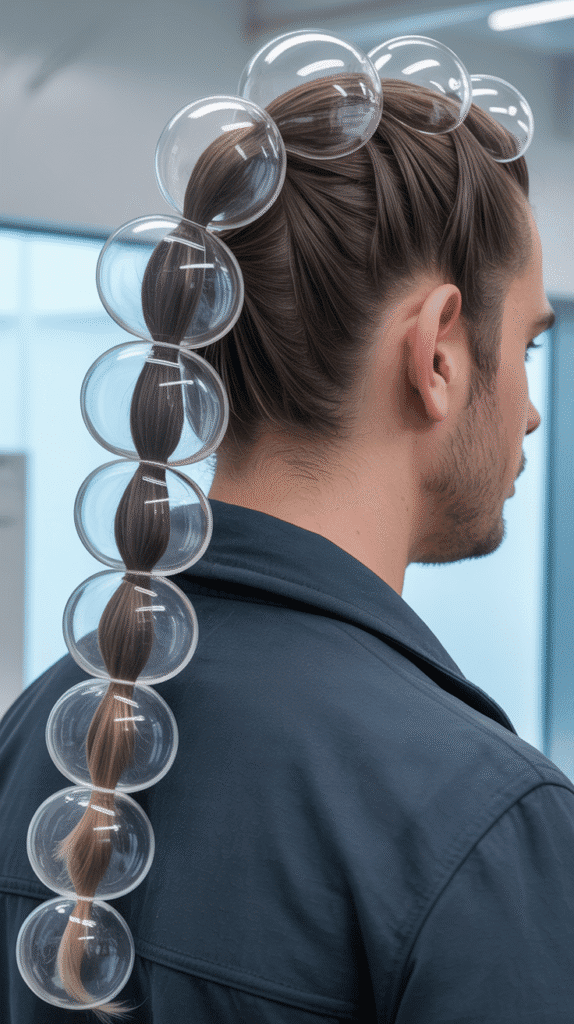
Bubble braids create a playful, dimensional effect by segmenting ponytails or braids into rounded “bubbles” using elastic bands placed at regular intervals.
While traditionally associated with casual or youthful styling, modern adaptations have made bubble braids increasingly popular for men seeking distinctive winter looks that balance fun aesthetics with practical hair management.
Creation Method:
- Hair is gathered into one or more ponytails as the foundation for the bubble structure
- Clear or color-matched elastics are placed at regular intervals down the length of each ponytail
- Hair between elastics is gently pulled and fluffed to create rounded bubble shapes
- The technique can be applied to single or multiple ponytails depending on desired coverage
Bubble Styling Options:
- Single central bubble braid creates a mohawk-like aesthetic with dimensional texture
- Side bubble braids on either side of a central part offer balanced, symmetrical styling
- Multiple smaller bubble braids throughout create overall textured, bouncy appearance
- Combining bubble sections with traditionally braided sections creates contrast and interest
Customization Possibilities:
- Bubble sizes can vary from small and numerous to large and dramatic
- Colored elastics add visual interest and create rhythm along the bubble structure
- Different elastic spacing creates irregular, organic bubble patterns versus uniform spacing
- The bubbles can be shaped to various degrees from subtle texture to extremely pronounced
Practical Benefits:
- The style keeps hair completely secured and manageable during winter activities
- Elastic placement allows for easy adjustability and tightening as needed throughout the day
- The technique works across various hair lengths from shoulder-length to very long
- Bubble braids can be created quickly compared to intricate braiding techniques, ideal for busy mornings
Winter Maintenance:
- The style typically lasts one day, requiring recreation for fresh appearance
- Elastics should be carefully removed to prevent hair breakage and damage
- The technique works well over previously braided or twisted hair, adding texture to protective styles
- Winter hats can flatten bubbles, so the style works best for indoor events or when hats won’t be worn
28. Braided Frohawk
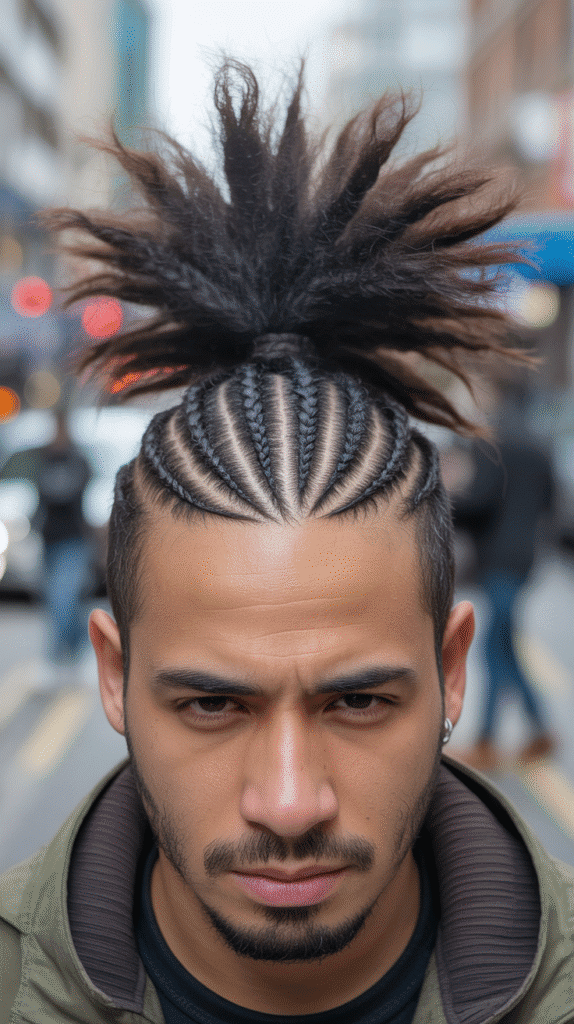
The braided frohawk celebrates natural hair texture while incorporating braiding techniques to create a mohawk-like shape with textured, voluminous styling.
This look combines the free, expressive nature of natural hair with the structure and definition that braiding provides.
Perfect for winter, the braided frohawk protects hair while making a bold, culturally rooted fashion statement.
Structural Elements:
- Sides are typically braided flat in cornrows directing hair toward the central mohawk section
- The central section features hair that’s either twisted, braided, or left in its natural textured state
- Width of the mohawk section determines how dramatic versus subtle the final appearance becomes
- Height is achieved through the natural volume of textured hair rather than products or extreme styling
Styling Techniques:
- Flat twists or cornrows on sides create clean contrast with the voluminous center section
- The mohawk section can feature twist-outs, braid-outs, or natural coils for maximum texture
- Strategic picking or fluffing of the central section achieves desired height and width
- Edge control defines the transition between flat sides and textured center
Cultural Significance:
- The frohawk celebrates natural African hair textures that have historically been marginalized
- The style rejects European beauty standards while creating contemporary, fashionable aesthetics
- Wearing natural texture prominently makes statements about cultural pride and self-acceptance
- The look has become increasingly mainstream, appearing in professional and formal contexts
Maintenance Approach:
- The braided sides can last 1-2 weeks while the central section requires daily refreshing
- Moisturizing the textured section prevents winter dryness and maintains definition
- Nighttime protection with bonnets or scarves preserves both braided sides and natural texture
- The style allows for variation by changing how the central section is styled day to day
29. Neo-Traditional Braids
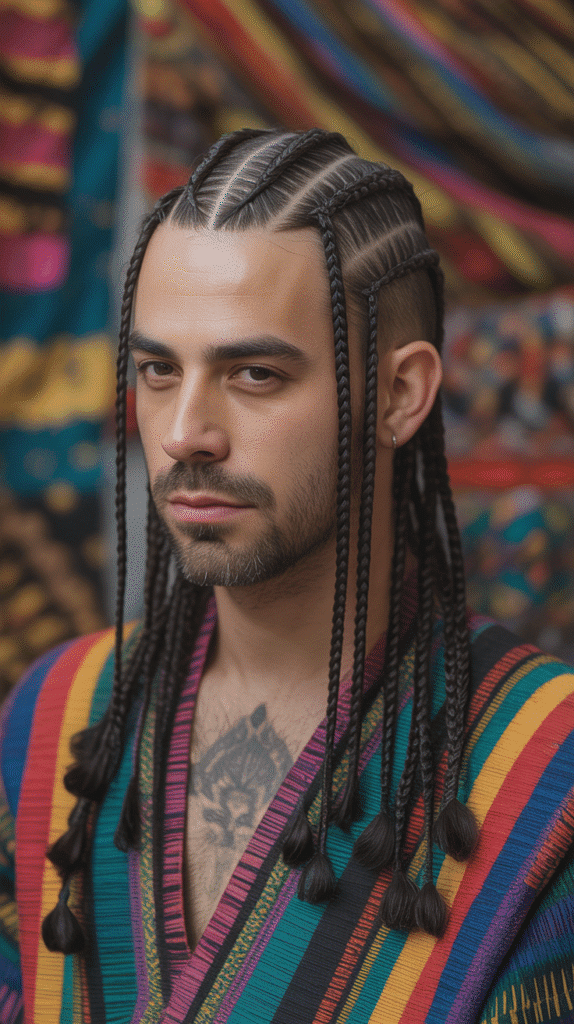
Neo-traditional braids blend classical braiding techniques with contemporary aesthetics, incorporating modern elements like asymmetry, unusual color placements, and unexpected pattern combinations.
This approach respects traditional braiding heritage while pushing creative boundaries to produce winter hairstyles that feel both rooted in history and decidedly current.
Design Philosophy:
- The style honors traditional braiding techniques while introducing contemporary creative interpretation
- Classic patterns are reimagined through modern lenses, creating familiar yet fresh aesthetics
- The approach balances respect for cultural tradition with individual creative expression
- Neo-traditional styling embraces both the protective function and artistic potential of braiding
Contemporary Elements:
- Asymmetrical patterns break from traditional symmetry to create modern, avant-garde looks
- Unexpected color combinations introduce contemporary fashion sensibilities to classical techniques
- Mixing different braid types and techniques within single styles creates eclectic, current aesthetics
- Incorporating modern accessories like metallic elements or unconventional materials updates traditional adornments
Cultural Bridge:
- The style creates dialogue between ancestral braiding practices and contemporary fashion culture
- Younger generations connect with cultural heritage through modernized interpretations
- The approach makes traditional techniques accessible and appealing to diverse audiences
- Neo-traditional styling respects origins while allowing personal interpretation and creativity
Application Examples:
- Traditional cornrow patterns executed in unconventional colors like platinum, pastels, or vibrant fashion shades
- Classic goddess braid structures combined with modern shaved designs or undercuts
- Historical bead placement patterns using contemporary materials like acrylic or silicone
- Tribal pattern inspiration applied asymmetrically or in unexpected head sections
30. Waterfall Braids
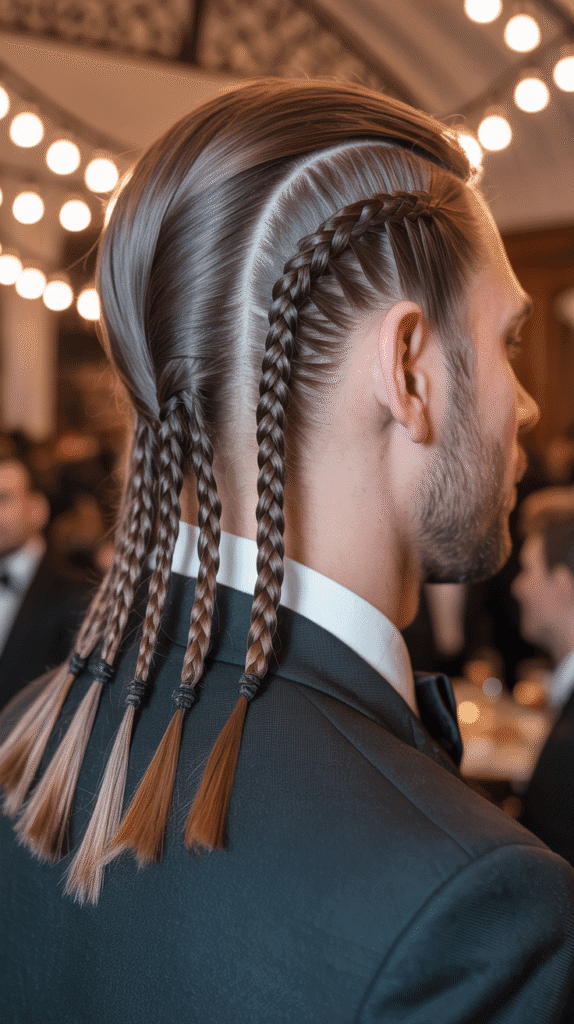
Waterfall braids create flowing, cascading effects by strategically releasing hair sections during the braiding process, allowing them to fall naturally while the braid continues.
This romantic, intricate technique produces hairstyles that appear complex and artistic while offering practical benefits for managing longer hair during winter.
The resulting look balances secured and loose sections for dynamic visual interest.
Braiding Technique:
- The method begins like standard French or Dutch braiding but releases one section with each cross
- Released sections fall naturally, creating the “waterfall” effect that names the technique
- New sections are continuously added to replace released ones, maintaining the ongoing braid
- The technique requires practice to maintain consistent tension while managing the released sections
Pattern Possibilities:
- Single waterfall braid running horizontally across the back or around the head like a crown
- Multiple waterfall braids at different heights create layered, cascading effects
- Diagonal waterfall paths add dynamic movement to the classic horizontal orientation
- Combining waterfall sections with fully braided areas creates contrast between secured and flowing hair
Aesthetic Qualities:
- The style creates romantic, artistic aesthetics often associated with special occasions and formal events
- The visible released sections showcase natural hair color, texture, and condition
- Winter lighting creates beautiful effects on the cascading sections, especially with highlights or natural color variation
- The intricate appearance suggests time and care invested in the styling
Practical Applications:
- Waterfall braids work best for winter indoor events rather than outdoor activities in harsh weather
- The style secures top sections while allowing length and movement in released pieces
- The technique works across various hair lengths from shoulder-length to very long
- Professional styling is recommended for special occasions, though simpler versions can be self-executed
31. Hybrid Twist-Braid Styles
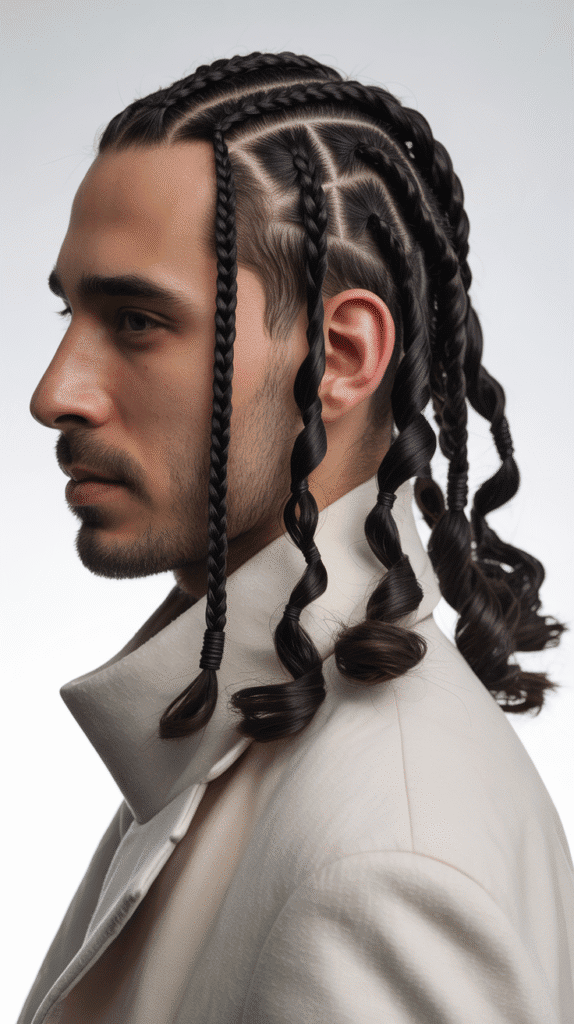
Hybrid styles intentionally combine braiding and twisting techniques within single hairstyles, creating textural contrast and visual complexity.
By alternating between three-strand braiding and two-strand twisting, or incorporating both methods in different head sections, these styles offer unique winter aesthetics that showcase technical versatility and creative vision.
Combination Approaches:
- Alternating individual braids and twists throughout the head creates checkerboard-like pattern variation
- Braided sections transitioning into twisted ends combine two techniques within single strands
- Braided sides with twisted top sections create textural contrast between different head areas
- Spiral combinations where twists wrap around braids produce complex, dimensional structures
Technical Execution:
- Smooth transitions between braiding and twisting require skilled technique and consistent tension
- Proper sectioning ensures each technique has adequate hair to maintain structural integrity
- The combination typically takes longer than single-technique styles due to the variation required
- Professional installation ensures clean execution and balanced integration of both methods
Visual Effects:
- The textural contrast between braids and twists creates depth and dimensional interest
- Different light reflection from smooth braids versus ropelike twists adds visual complexity
- The varied techniques can direct viewer attention to specific facial features or head areas
- Hybrid styles photograph particularly well due to the multiple textures and patterns present
Customization Options:
- The ratio of braiding to twisting can be adjusted based on personal preference
- Color application to either braided or twisted sections creates additional distinction
- Varying the size of braids versus twists intensifies or subtles the contrast effect
- Accessories can be applied selectively to one technique versus the other for asymmetrical decoration
32. Protective Starter Locs with Braids
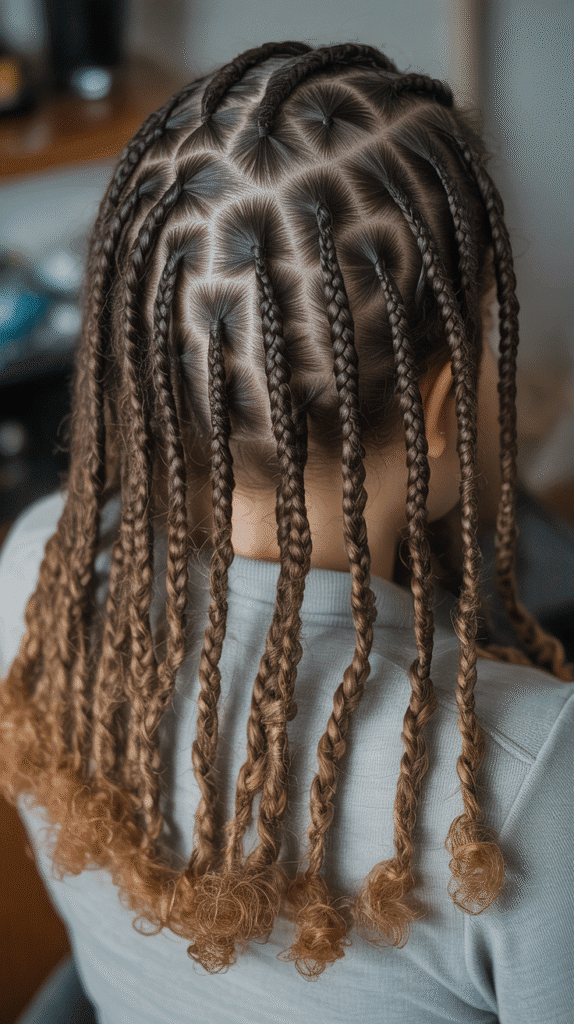
For men beginning their loc journey, incorporating braids into the starter phase provides structure, definition, and protection during the vulnerable early months.
Braiding techniques help hair begin the locking process while maintaining a neat, intentional appearance throughout the awkward initial stages.
This approach offers practical benefits while setting the foundation for mature locs that will develop over time.
Starting Methods:
- Individual sections are braided from root to tip, establishing the size and pattern for developing locs
- Braiding helps hair begin matting and tangling in controlled, intentional ways
- The technique provides definition during the fuzzy, undefined early loc stages
- Proper sectioning in the braiding phase determines the final loc pattern and size
Development Process:
- Braids are left in for several weeks, allowing hair to begin the locking process within the braided structure
- As braids are removed and rebraided, hair gradually tightens and develops loc characteristics
- The method takes longer than other loc-starting techniques but produces neater early-stage results
- Over 6-12 months, the braided structure gives way to genuine loc formation
Winter Advantages:
- Braided starter locs protect vulnerable new growth from harsh winter weather
- The secured style requires minimal daily maintenance during busy winter schedules
- The neat appearance maintains professional presentation throughout the unpredictable early stages
- Winter months provide ideal timing for starting locs, with mature development emerging by summer
Long-Term Considerations:
- Commitment to the loc journey requires understanding that the process takes months to years
- Regular maintenance appointments help starter locs develop properly without damage
- The braiding method is one of several starter techniques, each with distinct characteristics
- Patience during the early stages is essential as the hair transforms from braids to genuine locs
33. Seasonal Transitional Braids
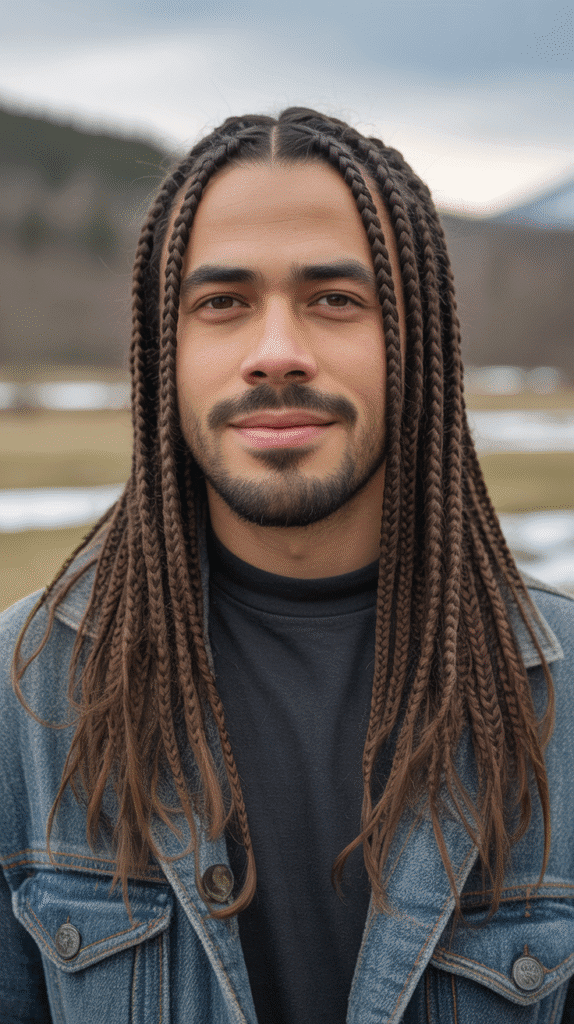
Seasonal transitional braids are designed specifically to carry hair from winter’s harsh conditions into spring’s renewal, incorporating elements that protect while preparing hair for eventual style changes.
These practical yet stylish approaches recognize that winter protective styles serve specific purposes and should facilitate healthy transitions as weather improves and styling goals evolve.
Transition Strategy:
- Styles are chosen with 6-8 week longevity that spans late winter into early spring
- Braiding techniques protect ends and minimize manipulation during the final harsh winter weeks
- The styles are designed for easy removal without causing damage when spring arrives
- Preparation for post-braid hair health is built into the styling approach
Style Characteristics:
- Medium-sized braids balance protection with manageable removal processes
- Avoiding excessively tight tension prevents damage that would complicate spring style changes
- Length considerations account for potential trimming needs when braids are removed
- The aesthetic remains current through winter social season while being practical rather than permanent
Preparation for Removal:
- Regular deep conditioning treatments during the braided period maintain hair health
- Protein treatments strengthen hair for the manipulation involved in braid removal
- Scalp care throughout winter ensures healthy foundation for spring growth
- Planning spring styles during winter allows for strategic transitional braiding choices
Health-Focused Approach:
- The transitional mindset prioritizes hair health over extended style longevity
- Recognizing when to remove braids prevents damage from over-wearing styles
- Post-braid recovery plans include treatments and gentle handling during the transition period
- The approach views winter braids as a chapter in ongoing hair care rather than isolated styling decisions
Conclusion
As we’ve explored throughout this comprehensive guide to 33 Stylish Winter Hair Braids for Men, the world of men’s braiding offers far more than simple hair management—it represents a rich intersection of cultural heritage, personal expression, and practical winter hair care.
From the timeless elegance of classic cornrows to the contemporary flair of neo-traditional styles, each braiding technique provides unique benefits tailored to different lifestyles, aesthetics, and hair protection needs during the challenging winter months.
Whether you’re drawn to the bold statement of a braided mohawk, the professional polish of a braided fade, or the cultural significance of tribal braids, there’s a winter braid style perfectly suited to your individual needs and personal style.
The protective benefits these styles offer—shielding your hair from harsh winds, dry indoor heating, and winter weather damage—make them practical choices that don’t sacrifice aesthetics for function.
As you embark on your braiding journey this winter, remember that proper maintenance, regular moisturizing, and choosing qualified professionals for complex installations are essential to achieving the healthy, stylish results you desire.
These 33 styles demonstrate that men’s hair braiding has evolved into a sophisticated art form that celebrates diversity, creativity, and the understanding that great style and excellent hair care can coexist beautifully throughout even the coldest winter season.
